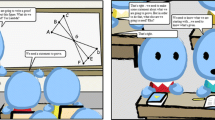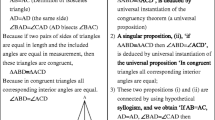Abstract
We investigated how US secondary mathematics teachers expect students to present geometric proofs at the board. We analyzed video records of geometry classrooms and found students to be engaged in a practice that we call proof transcription—i.e., mark-for-mark reproductions of previously completed proofs that were not reasoned reconstructions of arguments. To investigate whether or not US secondary mathematics teachers recognize transcriptions as routine occurrences when students presented proofs, we conducted a survey experiment. Participants (n = 60) viewed episodes of instruction and answered questions that elicited their reactions to those episodes. The analysis of open- and closed-ended responses to the survey indicated that participants recognized transcriptions as routine. Our study contributes a fine-grained description of what teachers expect from students when students are called to present their work at the board.



Similar content being viewed by others
Notes
Mathematics teachers are also obligated to recognize and serve students as individual learners; to oversee the interpersonal dynamics of the students in the class (e.g., how students talk to one another or share communal classroom resources); and to enforce school rules, work within specific curricular frameworks, or comply with policies that pertain to schooling as an institution (see Herbst & Chazan, 2012).
Dimmel and Herbst (2015) describe a variety of these markings, including hash marks on strokes to associate segments which are congruent, and others.
We focus here on student presentations of proofs. For a multimodal analysis of a disciplinary expert’s presentation of a proof, see Núñez, 2009 (p. 321–324).
The data analyzed in this report are a subset of data that were gathered as part of a dissertation study (see Dimmel, 2015). In addition to the sequence norm, the larger study investigated the kinds of details that teachers expected in students’ written proofs (Dimmel & Herbst, 2018). There were five experimental groups in total for the data collection for the larger study, but only four of those groups were included in the experimental design for the sequence norm portion of the study that is reported here. Groups A, B, C, and D of this study correspond to Groups 1, 3, 4, and 5 (respectively) of the larger study.
The choices for the closed-ended rating questions were: 1 (very inappropriate), 2 (inappropriate), 3 (somewhat inappropriate), 4 (somewhat appropriate), 5 (appropriate), 6 (very appropriate).
We acknowledge the support of Nicolas Boileau for his assistance with the reliability study.
References
Artemeva, N., & Fox, J. (2011). The writing’s on the board: The global and the local in teaching undergraduate mathematics through chalk talk. Written Communication, 28(4), 345–379. https://doi.org/10.1177/0741088311419630
Atkinson, P. (1988). Ethnomethodology: A critical review. Annual Review of Sociology, 14, 441–465. https://doi.org/10.1146/annurev.so.14.080188.002301
Bergqvist, T. (2005). How students verify conjectures: Teachers’ expectations. Journal of Mathematics Teacher Education, 8(2), 171–191. https://doi.org/10.1007/s10857-005-4797-6
Buchbinder, O., Chazan, D. I., & Capozzoli, M. (2019). Solving equations: Exploring instructional exchanges as lenses to understand teaching and its resistance to reform, Journal for Research in Mathematics Education, 50(1), 51–83. https://doi.org/10.5951/jresematheduc.50.1.0051
Dimmel, J. K. (2015) How do teachers expect students to represent mathematical work? A study of teachers’ recognition of routine ways that proofs are presented and checked in high school geometry (Unpublished doctoral dissertation). Ann Arbor, University of Michigan.
Dimmel, J. K., & Herbst, P. G. (2015). The semiotic structure of geometry diagrams: How textbook diagrams convey meaning. Journal for Research in Mathematics Education, 46(2), 147–195. https://doi.org/10.5951/jresematheduc.46.2.0147
Dimmel, J. K., & Herbst, P. G. (2018). What details do teachers expect from student proofs? A study of proof checking in geometry. Journal for Research in Mathematics Education, 49(3), 261–291. https://doi.org/10.5951/jresematheduc.49.3.0261
Fukawa-Connelly, T. (2012). Classroom sociomathematical norms for proof presentation in undergraduate in abstract algebra. The Journal of Mathematical Behavior, 31(3), 401–416. https://doi.org/10.1016/j.jmathb.2012.04.002
Garfinkel, H. (2017). A conception of and experiments with “trust” as a condition of concerted stable actions. In J. O’Brien (Ed.), The production of reality: Essays and readings on social interaction (4th ed.pp. 483–495). (Original work published in 1963)). Los Angeles, CA: Sage.
Greiffenhagen, C. (2014). The materiality of mathematics: Presenting mathematics at the blackboard. The British journal of sociology, 65(3), 502–529. https://doi.org/10.1111/1468-4446.12037
Gwet, K. L. (2014). Handbook of inter-rater reliability: The definitive guide to measuring the extent of agreement among raters. Gaithersburg, MD: Advanced Analytics, LLC.
Herbst, P. (2002). Establishing a custom of proving in American school geometry: Evolution of the two-column proof in the early twentieth century. Educational Studies in Mathematics, 49, 283–312. https://doi.org/10.1023/A:1020264906740
Herbst, P. G. (2006). Teaching geometry with problems: Negotiating instructional situations and mathematical tasks. Journal for Research in Mathematics Education, 37(4), 313–347 https://www.jstor.org/stable/30034853
Herbst, P., Aaron, W., Dimmel, J., & Erickson, A. (2013a). Expanding students’ involvement in proof problems: Are geometry teachers willing to depart from the norm? Paper presented at the 2013 meeting of the American Educational Research Association, San Francisco, CA. Deep Blue at the University of Michigan http://hdl.handle.net/2027.42/97425
Herbst, P., & Brach, C. (2006). Proving and doing proofs in high school geometry classes: What is it that is going on for students? Cognition and Instruction, 24(1), 73–122. https://doi.org/10.1207/s1532690xci2401_2
Herbst, P., & Chazan, D. (2012). On the instructional triangle and sources of justification for actions in mathematics teaching. ZDM, 44(5), 601–612. https://doi.org/10.1007/s11858-012-0438-6
Herbst, P., & Chazan, D. (2015). Using multimedia scenarios delivered online to study professional knowledge use in practice. International Journal of Research and Method in Education, 38(3), 272–287. https://doi.org/10.1080/1743727X.2015.1025742
Herbst, P., Chazan, D., Chen, C. L., Chieu, V. M., & Weiss, M. (2011a). Using comics based representations of teaching, and technology, to bring practice to teacher education courses. ZDM, 43(1), 91–103. https://doi.org/10.1007/s11858-010-0290-5
Herbst, P., Chen, C., Weiss, M, & González, G., Nachlieli, T., Hamlin, M., & Brach, C. (2009). “Doing proofs” in geometry classrooms. In D.A. Stylianou, M.L. Blanton, & E.J. Knuth (Eds.), Teaching and learning proofs across the grades: A K-16 perspective, (pp. 250–268). New York, NY: Routledge.
Herbst, P., Dimmel, J., & Erickson, A. (2016). High school mathematics teachers’ recognition of the diagrammatic register in proof problems. Paper presented at the Annual Meeting of the American Educational Research Association, Washington DC.
Herbst, P. G., Kosko, K. W., & Dimmel, J. K. (2013b). How are proof problems presented? Conceptualizing and measuring teachers’ recognition of the diagrammatic register. In M. Martinez & A. Castro Superfine (Eds.), Proceedings of the 35th annual meeting of the north American chapter of the International Group for the Psychology of Mathematics Education (pp. 179–186). Chicago, IL: University of Illinois at Chicago.
Herbst, P., Nachlieli, T., & Chazan, D. (2011b). Studying the practical rationality of mathematics teaching: What goes into “installing” a theorem in geometry? Cognition and Instruction, 29(2), 218–255. https://doi.org/10.1080/07370008.2011.556833
Jewitt, C. (Ed.). (2009). The Routledge handbook of multimodal analysis. London, UK: Routledge.
Kress, G., & Van Leeuwen, T. (2006). Reading images: The grammar of visual images. Oxon, UK: Routledge.
Livingston, E. (1986). The ethnomethodological foundations of mathematics. Abigdon-on-Thames, UK: Routledge Kegan & Paul.
Lockhart, P. (2009). A mathematician’s lament. New York, NY: Bellevue Literary Press.
Malmstrom, H., & Eriksson, D. (2018). Communicating to learn multivariable Calculus: Students’ blackboard presentations as a means for enhancing mathematics learning. PRIMUS, 28(8), 726–741. https://doi.org/10.1080/10511970.2017.1408045
Martin, J., & White, P. (2007). The language of evaluation: Appraisal in English. New York, NY: Palgrave Macmillan.
Mehan, H., & Wood, H. (1975). The reality of ethnomethodology. New York, NY: Wiley.
Miller, D., Infante, N., & Weber, K. (2018). How mathematicians assign points to student proofs. The Journal of Mathematical Behavior, 49, 24–34. https://doi.org/10.1016/j.jmathb.2017.03.002
Moore, R. C. (2016). Mathematics professors’ evaluation of students’ proofs: A complex teaching practice. International Journal of Research in Undergraduate Mathematics Education, 2(2), 246–278. https://doi.org/10.1007/s40753-016-0029-y
Munoz, S. R., & Bangdiwala, S. I. (1997). Interpretation of kappa and B statistics measures of agreement. Journal of Applied Statistics, 24(1), 105–112. https://doi.org/10.1080/02664769723918
Núñez, R. E. (2009). Gesture, inscriptions, and abstraction: The embodied nature of mathematics or why mathematics education shouldn’t leave the math untouched. In W. M. Roth (Ed.), Mathematical representation at the interface of body and culture (pp. 309–328). Charlotte, NC: Information Age Publishing.
O’Halloran, K. (2005). Mathematical discourse: Language, symbolism and visual images. New York, NY: Continuum.
Schoenfeld, A. H. (1988). When good teaching leads to bad results: The disasters of “well-taught” mathematics courses. Educational Psychologist, 23(2), 145–166. https://doi.org/10.1207/s15326985ep2302_5
Stylianides, A. J. (2019). Secondary students’ proof constructions in mathematics: The role of written versus oral mode of argument representation. Review of Education, 7(1), 156–182. https://doi.org/10.1002/rev3.3157
Tabach, M., Barkai, R., Tsamir, P., Tirosh, D., Dreyfus, T., & Levenson, E. (2010). Verbal justification—is it a proof? Secondary school teachers’ perceptions. International Journal of Science and Mathematics Education, 8(6), 1071–1090. https://doi.org/10.1007/s10763-010-9230-7
Thurston, W. (1994). On proof and progress in mathematics. Bulletin of the A.M.S, 30, 161–177. https://doi.org/10.1090/S0273-0979-1994-00502-6
Funding
This research was supported in part by Rackham Merit Fellowship from the University of Michigan (first author). The video archive was collected with the support of NSF grant REC-0133619 and the experiment data with NSF grant DRL-0918425 (P. Herbst, PI). The Opinions expressed here are the authors’ and do not reflect the views of the University of Michigan or the National Science Foundation.
Author information
Authors and Affiliations
Corresponding author
Additional information
Publisher’s note
Springer Nature remains neutral with regard to jurisdictional claims in published maps and institutional affiliations.
The research reported here is based on the first author’s doctoral dissertation at the University of Michigan, for which the second author served as the dissertation committee chair. Please address correspondence concerning this article to Justin K. Dimmel, School of Learning and Teaching, University of Maine, 330 Shibles Hall, Orono, ME 04469.
Rights and permissions
About this article
Cite this article
Dimmel, J.K., Herbst, P.G. Proof transcription in high school geometry: a study of what teachers recognize as normative when students present proofs at the board. Educ Stud Math 105, 71–89 (2020). https://doi.org/10.1007/s10649-020-09975-y
Published:
Issue Date:
DOI: https://doi.org/10.1007/s10649-020-09975-y




